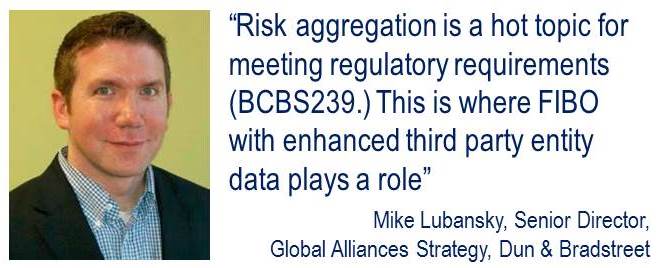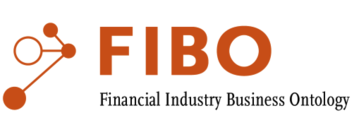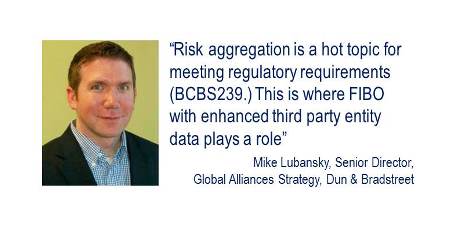 Mike Lubansky, Dun & Bradstreet’s Leader of Alliances Strategy, focusing on Capital Markets, Compliance, and Tax Solutions, gave an interview about FIBO, the increasingly important data standard being developed in the financial industry.
Mike Lubansky, Dun & Bradstreet’s Leader of Alliances Strategy, focusing on Capital Markets, Compliance, and Tax Solutions, gave an interview about FIBO, the increasingly important data standard being developed in the financial industry.
Lubansky comments centered on questions such as:
What are the pain-points financial companies are experiencing that FIBO helps solve? Many industries have the challenge of rationalizing disparate sources of data and consolidating quality data into one place that is consistent and easy to understand, including when the meaning of data is interrelated.
 How FIBO works and how it’s being developed? For instance the EDM Council has been the flag bearer for FIBO with input from regulators. Standards boards are also involved including the Objects Management Group (OMG), an international standards consortium. FIBO has different working groups and they’re each building out ontology semantics around different aspects of financial services.
How FIBO works and how it’s being developed? For instance the EDM Council has been the flag bearer for FIBO with input from regulators. Standards boards are also involved including the Objects Management Group (OMG), an international standards consortium. FIBO has different working groups and they’re each building out ontology semantics around different aspects of financial services.
What role and value do supplemental business data and analytics provide to enhance FIBO’s use? Risk aggregation is a hot topic for meeting regulatory requirements – as an example, the Basel Committee on Banking Supervision (BCBS239.) This is where FIBO with enhanced third-party entity data plays a role.
A financial services organization may have a reference database with business entity data, but it may not have as clear a view of business entities that are related in terms of ownership and control relationships. Real value emerges when core entity data includes related entity associations, such as legal ownership corporate hierarchies (where one company owns greater than 50% of another company), alternative linkage (minority ownership relationships where one company owns less than 50% of another company) and beneficial ownership (where an individual owns or controls more than 25% of a company’s shares or voting rights, or who otherwise exercises control over the company or its management.)
Once a financial services firm can see the related hierarchy of transactions and interrelated business entities, it can then create more meaningful analytics and perform risk aggregation to understand country risk and transitive risk exposure.
Utilizing all relevant data sources available and ontology to structure the data into a clear view of business entities and their relationships help reveal risk and opportunity. And it’s catching the attention of the industry.
Stay tuned for the second part of this blog, which will illustrate an active proof of concept with a leading bank who is testing the FIBO standard with D&B data inside an analytical tool for risk analysis purposes.
The full text of the interview is available on dnb.com/perspectives/data management
Mike Lubansky leads a team of solution strategists focused on developing new uses for Dun & Bradstreet content in the Capital Markets and Compliance space. He also works closely with D&B’s Partner Innovation Center, which is developing various prototype solutions, including use of graph database technology and FIBO to address Capital Markets challenges.
 About FIBO: The Financial Industry Business Ontology (FIBO) is a business conceptual ontology developed by the members of the EDM Council. FIBO provides a description of the structure and contractual obligations of financial instruments, legal entities and financial processes. FIBO is used for harmonization of data across repositories as a common language (i.e. Rosetta stone) for risk analysis and business process automation. FIBO is expressed in the triplestore language of the Web (RDF/OWL) for machine readable inference processing and UML for people readable analysis.
About FIBO: The Financial Industry Business Ontology (FIBO) is a business conceptual ontology developed by the members of the EDM Council. FIBO provides a description of the structure and contractual obligations of financial instruments, legal entities and financial processes. FIBO is used for harmonization of data across repositories as a common language (i.e. Rosetta stone) for risk analysis and business process automation. FIBO is expressed in the triplestore language of the Web (RDF/OWL) for machine readable inference processing and UML for people readable analysis.






















